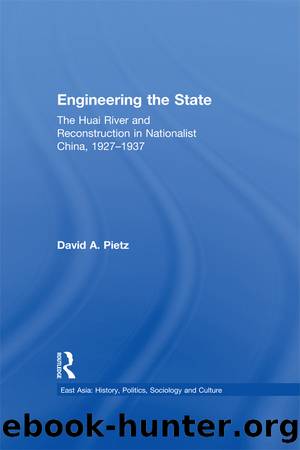Engineering the State by David Pietz

Author:David Pietz [Pietz, David]
Language: eng
Format: epub
Tags: History, Asia, General
ISBN: 9780415933889
Google: Kfd3NSLOIlUC
Publisher: Psychology Press
Published: 2002-01-15T03:40:06+00:00
Provincial Organization
Effective coordination with provincial and local structures was critical in organizing relief operations. These attempts met with varying degrees of success. In Jiangsu, the provincial relief organization was able to operate with a fair degree of coordination with the NFRC. In outlying provinces such as Hunan, Hubei, and Anhui, a greater degree of political independence from the Nanjing Government manifested itself in the autonomy that these provincial relief organizations sought.
In Hubei the NFRC struggled to impose administrative authority over emergency and labor relief. Relations between the NFRC and the Hubei Provincial Rehabilitation Committee were ill defined and fraught with disagreements and disputes. The provincial committee is reported to have complained that it had very little reliable information from the NFRC concerning the amount of wheat the province had been allotted.36 The provincial committee independently set up relief camps and wished to maintain administrative independence, but it also wanted to âhave its relations with the National Flood [Relief] Commission placed on a substantial footing.â37 The NFRC on the other hand was willing to grant a certain degree of autonomy to the Hubei committee, but demanded that it retain technical control over dike engineering and inspection and power of audit over wheat and monetary allocations. The NFRC indicated that it would send a representative to Hubei to assist in relief, but this âwas not welcomed with any enthusiasm ⦠the local people are very jealous of any interference from the outside in the work of relief and any supervision that may be attempted will have to be very judicially [sic] exercised.â38
In Hunan, obstruction of NFRC efforts arose because of regional peculiarities of water control systems and a desire to maintain provincial authority. In the overall scheme of labor relief adopted by the NFRC and applied to all provinces, main dikes (or public dikes) were to be repaired by subsidies of wheat from the Field Operations Department, while smaller private dikes were to be repaired by owners at their own expense. In Hunan, however, there were no public dikes. Irrespective of size, all were private. The provincial authorities demanded that wheat should be used to stimulate all dike reconstruction. Hunan authorities also demanded that wheat not be given as âwagesâ for dike repair, but be advanced as a loan subject to repayment after two years.39
The NFRCâs solutions to problems in Hunan represented a significant devolution of NFRC administrative power. In effect, the Vice-Chairman of the Hunan Provincial Rehabilitation Bureau was given full responsibility over emergency relief, labor relief, and farm rehabilitation (three separate divisions of the formal NFRC organization). In addition, all local engineers were placed under his direct supervision, and wheat allocations made upon his directives. The Hunan Provincial Rehabilitation Committee did not object to demands from the NFRC that inspectors be dispatched from Nanjing to audit accounts and wheat allotments, but these âoutside authorities are not empowered to interfere with the distribution of the wheat, or with the arrangements made by the local rehabilitation bureau for its use.â Given the
Download
This site does not store any files on its server. We only index and link to content provided by other sites. Please contact the content providers to delete copyright contents if any and email us, we'll remove relevant links or contents immediately.
Harry Potter and the Goblet Of Fire by J.K. Rowling(3045)
Never by Ken Follett(2880)
Shadow of Night by Deborah Harkness(2718)
Ogilvy on Advertising by David Ogilvy(2682)
Zero to IPO: Over $1 Trillion of Actionable Advice from the World's Most Successful Entrepreneurs by Frederic Kerrest(2393)
The Man Who Died Twice by Richard Osman(2298)
Machine Learning at Scale with H2O by Gregory Keys | David Whiting(2291)
Book of Life by Deborah Harkness(2263)
How Proust Can Change Your Life by Alain De Botton(2261)
My Brilliant Friend by Elena Ferrante(2223)
0041152001443424520 .pdf by Unknown(2220)
The Tipping Point by Malcolm Gladwell(2204)
How to Pay Zero Taxes, 2018 by Jeff A. Schnepper(2099)
Will by Will Smith(2041)
Purple Hibiscus by Chimamanda Ngozi Adichie(1981)
Hooked: A Dark, Contemporary Romance (Never After Series) by Emily McIntire(1959)
Borders by unknow(1785)
Rationality by Steven Pinker(1765)
Daughter of Smoke and Bone by Laini Taylor(1744)
